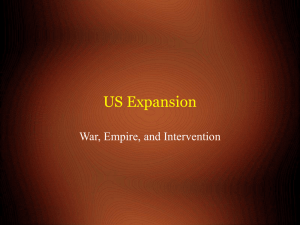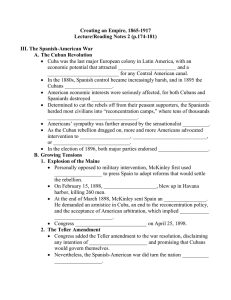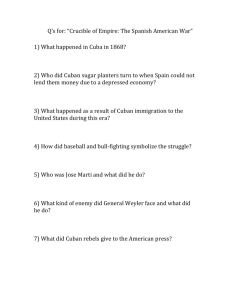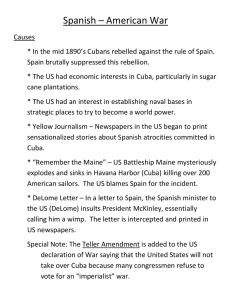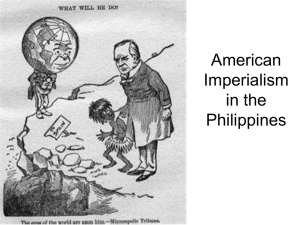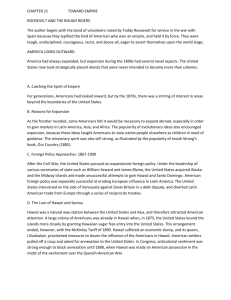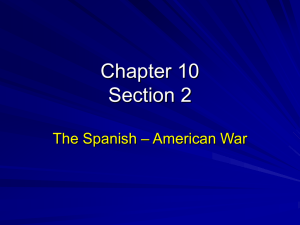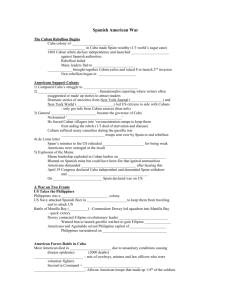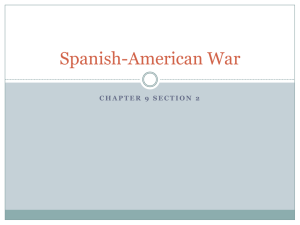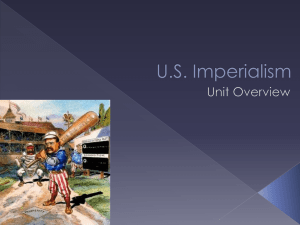Imperialism
advertisement
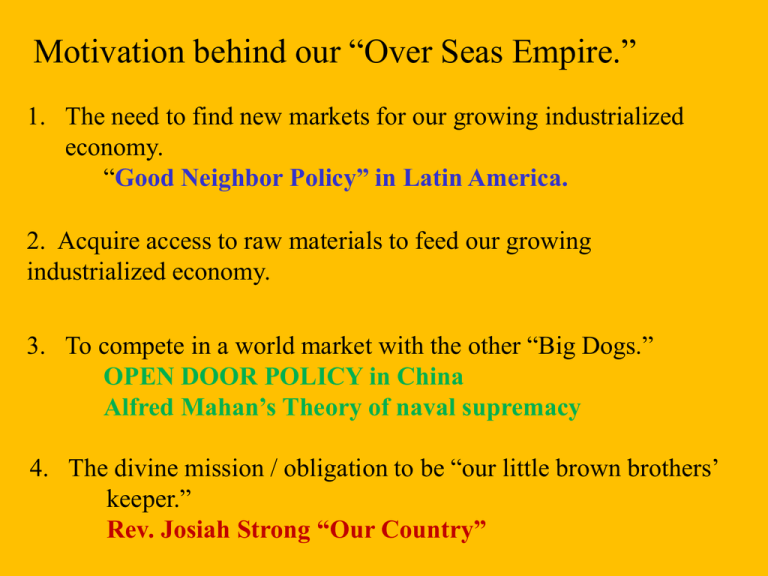
Motivation behind our “Over Seas Empire.” 1. The need to find new markets for our growing industrialized economy. “Good Neighbor Policy” in Latin America. 2. Acquire access to raw materials to feed our growing industrialized economy. 3. To compete in a world market with the other “Big Dogs.” OPEN DOOR POLICY in China Alfred Mahan’s Theory of naval supremacy 4. The divine mission / obligation to be “our little brown brothers’ keeper.” Rev. Josiah Strong “Our Country” The ROOTS OF WAR: The Monroe Doctrine = Divides the world into “Spheres of Influence.” Cuba= Colony of Spain. Spain= Once powerful Empire. U.S.= Up and coming world power. Monroe Doctrine • A desire to become a world power and protect our interests in the Caribbean and beyond. •Cuban Concentration Camps. •Yellow journalism stories about Spanish atrocities and McKinley is too weak to fight public sentiment. JOSEPH PULLITZER vs. WILLIAM HEARST •De Lome letter that embarrassed McKinley and America •Explosion on U.S.S. Maine (Spain blamed) Our Goal: To liberate the Cubans from the Spanish Empire. BUT FIRST, It’s “Off to the Philippines…” “. . . it shows once more what McKinley is: weak and catering to the rabble, and, besides, a low politician, who desires to leave a door open to me and to stand well with the jingoes of his party.” Before After Admiral George Dewey captured Manila Bay (Philippines) with the aid of Filipino revolutionary leader, Emilio Aguinaldo By July he had defeated the Spanish at the Philippines The American army was ill prepared for war in the Caribbean (wool uniforms, lack of training, poor food storage) The most famous battle was the charge up San Juan Hill The charge up San Juan Hill was credited to Teddy Roosevelt and the Rough Riders, though it was the Tenth Negro Cavalry (a.k.a. Buffalo Soldiers) who were responsible for taking the hill, the Rough Riders actually charged up Kettle Hill With little loss of American life, the U.S. military forces the surrender of the Spanish and liberates Cuba. Spain agrees to the term of the Treaty of Paris. THE EFFECTS: 1. U.S. becomes a world power. (Top 5) -begins colonizing other lands. Acquires Guam, The Philippines, Puerto Rico, AND CUBA from Spain. 2. Spanish Empire destroyed. Teller Amendment = Congressional resolution passed prior to the start of war stating that once the war was over and Cuba was independent, the USA would “leave control of the island to its people” Treaty of Paris (Dec. 10, 1898) = Cuba gained independence, America was given Puerto Rico and Guam as colonies, and Spain sold the Philippines to America for $20 million Platt Amendment = agreement between the USA and Cuba in 1902 that gave the USA the right to intervene in Cuban affairs if “for the protection of life, property, and individual liberty” and forced Cuba to lease Guantanamo Bay as an American naval base We could not leave them to themselves – they were unfit for self-government, and would soon have anarchy and misrule worse than Spain’s was . . . There was nothing left for us to do but to take them all, and to educate the Filipinos, and uplift and civilize and Christianize them . .. -President William McKinley •Filipino rebels – led by Emilio Aguinaldo – fought alongside US forces in the Spanish-American War •USA bought the Philippines from Spain for $20 million as part of the Treaty of Paris (1898) •Aguinaldo issued a proclamation of independence in January 1899 – declaring the Philippines a republic •USA ignored the proclamation and proceeded to suppress the independence movement •Vicious fighting lasted for 3 years: •4,000 American soldiers KIA •3,000 American soldiers wounded •16,000 Filipino soldiers KIA •200,000 Filipino civilians killed •Occasional fighting continued for years •During the Japanese occupation of the Philippines in WWII, Aguinaldo made an infamous radio address in support of the Japanese (referring to them as liberators) •Aguinaldo was imprisoned by the USA (in his trial as a collaborator, he testified that the Japanese forced him to make the address) •The Philippines were granted independence in 1946 Fast Forward to Today Victory in the Spanish-American War touched off a new era in the United States. Its role in world affairs forever changed; the United States became involved in many foreign conflicts over the next century. 1917 = WWI 1941 = WWII 1950 = Korea 1964 = Gulf of Tonkin Resolution – Vietnam 1991 = Persian Gulf War (invasion of Kuwait) 2001 = Invasion of Afghanistan (to depose the Taliban) 2003 = Invasion of Iraq (to depose Saddam Hussein)

